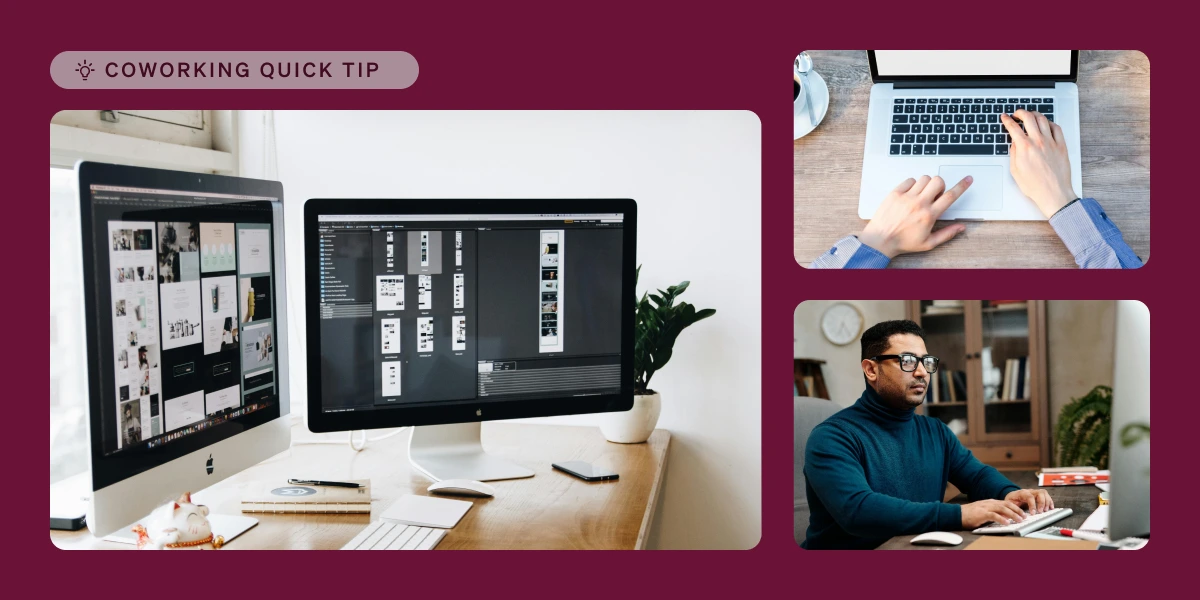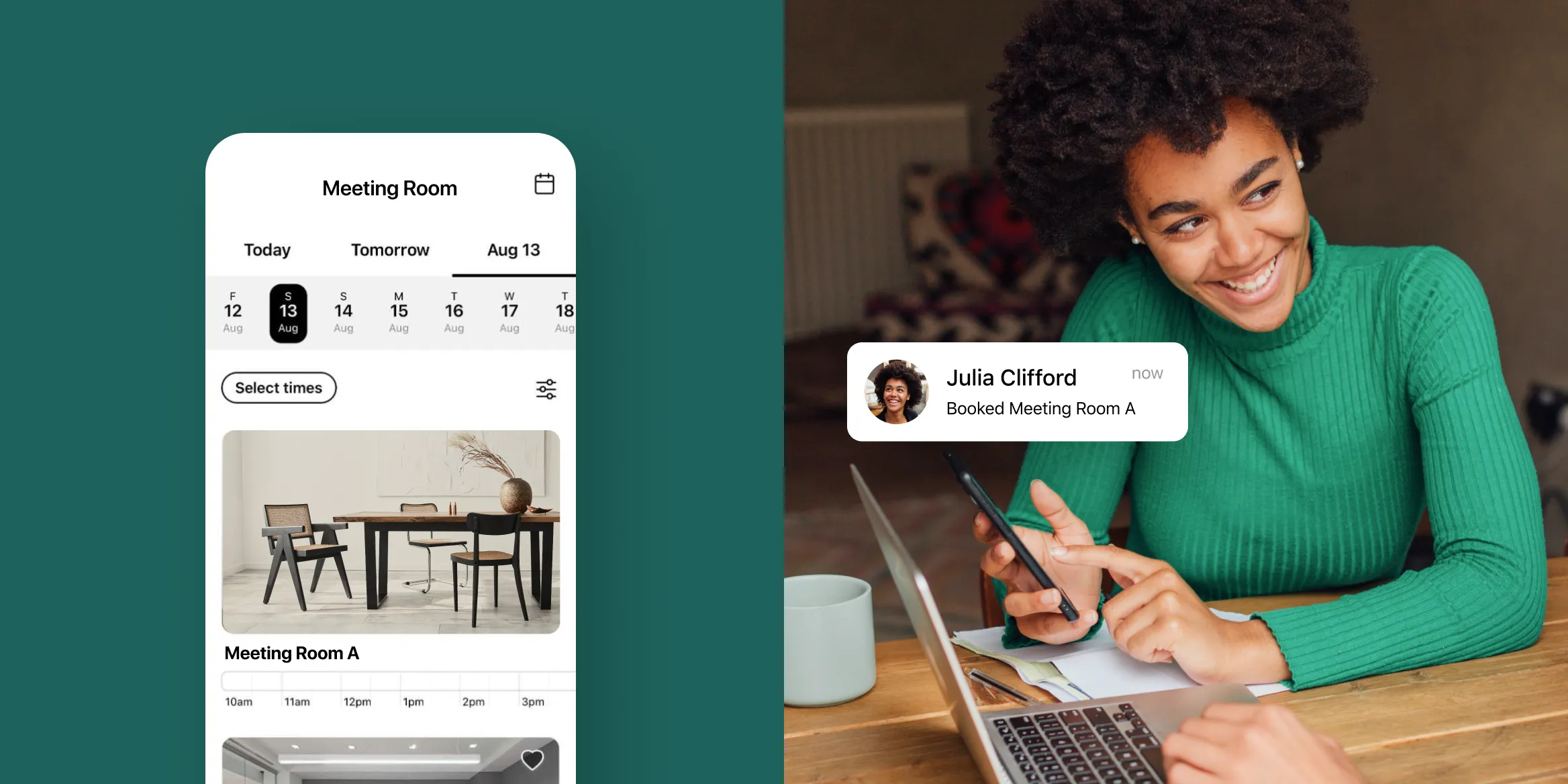When designing a coworking space, you need the space to be functional but inspiring, practical but welcoming, professional but homey, the list goes on and on.
We sat down with Optix CEO, Founder, and former coworking space operator Kia Rahmani, to learn his method for designing a coworking space. He broke it down for us step-by-step to create the easiest coworking design guide on the internet.
If you’re building out a coworking space from scratch and you’re not sure how to get started, this is the guide for you!
Coworking space design requirements
Before we go into detail on how to design a coworking space, let’s take a look at what is required for a well-designed coworking space.
- Beautiful interior design that speaks directly to your target audience.
- Great lighting including plenty of natural light.
- Lots of flexible seating options like standing desks, couches, ergonomic chairs, high-top tables, and more.
- A functional layout that makes sense and is easy to move around.
- An accessible space that includes indoor mapping, accessible parking spaces, and ramps.
- Acoustics and sound-proofing, especially for conference rooms, private offices, and phone booths.
- Dedicated quiet areas for those looking for focused time.
- Open areas for daily drop-ins and cultivating member connections.
The beautiful thing to remember is there is so much flexibility in how you design your space. Really the biggest requirement is ensuring you create something that supports people in being their best, most productive selves.
Learn how Optix can transform your business

How to design a coworking space
Let’s look at how to go about designing a coworking space, as shared with us by Kia Rahmani.
How to design a coworking space: step by step
- Step 1: Start with your business model
- Step 2: Figure out what your needs are
- Step 3: Configure a floor plan
- Step 4: Begin the buildout
- Step 5: Find the right furniture
- Step 6: Deploy the right tech
- Step 7: Stay agile and embrace experimentation
Step 1: Start with your business model
The first step in designing your space is to figure out your business model. Understanding how your space makes money will help determine your product offering and therefore, your overall layout. For example:
- Is your focus on selling long-term team spaces? You’ll want large private offices.
- Are you catering to daily drop-ins and travelers? Dedicated desks and open spaces will be paramount to your design.
- Do you want to rent out event space? You’ll need large open spaces that are sectioned off from the rest of the space.
Another way of thinking about it is to consider your ideal client profile (ICP) and what kind of space they’ll need. A coworking space for startups may require more meeting room availability, while a space for solopreneurs would benefit more from private offices.
Once you have your business model, you can work backwards from there. If you expect large-scale changes to your business model or what you offer (which is common), set up your space so it’s modular and easy to change.
In a recent Coworking Resources webinar, David Walker, Founder at coworkingconsulting.com said that an 80/20 mix of private offices to open space is ideal for profitability.
Step 2: Figure out what your needs are
Once you determine your business model, you’ll need to figure out what the needs of your business are. Kia recommends using the framework of Services and Essentials to help organize your needs.
Services
Services are the large, physical resources you’ll provide to your members. For most coworking spaces, this is some combination of:
- Individual desks
- Private offices
- Meeting or conference rooms
- Event space
You may find it helpful to write out the exact number of each resource you’ll need in order to hit your revenue targets.
Essentials
Essentials are non-negotiables that you’ll need to include in your space. These are things that your space will need to have, regardless of your business model or demographic served. It can include things like:
- Kitchen or food area
- Bathroom(s)
- Closet/storage space
- Employee break room or personal office
Together, Services and Essentials make up everything that will be in your coworking space.
The goal of this step is to get a comprehensive overview of all of the pieces that will fit inside of your coworking space. Think of an empty coworking space as the outline of a puzzle. Your Services and Essentials are the puzzle pieces that perfectly fit inside of your outline to create a seamless and integrated coworking space.
Now, it’s time to put the puzzle together.
Step 3: Configure a floor plan
There’s a lot we don’t think about when we enter into a well-designed space, like lighting, kitchen layout, or common room access. But as Kia notes, these are some of the most important things to consider.
At this step, you’ll figure out how big your open space will be, the size of your private offices, how many desks you can fit in your team rooms, and more.
Here are some tips for thinking about your floor plan:
- Get inspiration from other spaces: talk to other coworking owners about their layout or visit other coworking spaces in your area. Look at how they’ve set up their space and consider what you like and dislike about their floor plans.
- Do your research on what makes a great space: look into office design and office design principles to figure out the best way to lay out your coworking space.
- Look at (lots) of floor plans: there are plenty of example coworking space floor plans on the internet. A quick search will help you discover inspiration for designing an effective space.This article has lots of great design inspiration for your floor plan as well.
- Employ the help of a professional: an architect or interior design firm is a great place to start for some expert advice. They can work with your contractor to put together something that is seamless, beautiful, and functional.
When you’re ready to get started with your floor plan, you can use a tool like MagicPlan or RoomSketcher to help you design it. These are digital platforms that help you create floor plans, 3D renderings, and more on your mobile device or tablet. They are easy to use and super helpful if you’re unfamiliar with office design.
Step 4: Begin the buildout
A buildout is all of the construction inside of your commercial space. If you’re not familiar with a buildout, this guide does a good job of explaining the concept.
At this stage, you’ll employ the help of a contractor to oversee the process. You’ll work closely with their team to ensure everything runs smoothly. You may also want to bring in a designer or architect at this stage.
The cost of a buildout varies on the size of the space, the area you’re in, and your tenant improvement allowance (TI). TI helps subsidize the total cost of the buildout by covering a fixed amount of the cost.
According to an article by WeWork, you can expect to pay anywhere between $50 to $150 a square foot for a commercial buildout. This cost is often split between landlord and tenant in the case of a commercial building.
You may even be able to get your landlord to pay for the entirety of the buildout by pursuing a flexible lease arrangement, such as a coworking management agreement.
For more information about how much it costs to start a coworking space, check out our updated article.
Step 5: Find the right furniture
Now that the buildout is out of the way, it’s time to get creative. This means finding the right furniture and landing on the overall design and aesthetic of your coworking space.
Below are some best practices when choosing furniture for your space:
- Don’t sacrifice design for comfort (or vice versa). Both are equally important for member satisfaction.
- Opt for ergonomic furniture. Knowledge workers spend 2,080 hours a year sitting. Using ergonomic chairs and placements means the hours they spend sitting with you will at least be more comfortable.
- Look at the big picture. Consider how all of the pieces will fit together, both in a single area and in your entire space.
- Go with the best you can afford. Furniture is an opportunity to create more than just a place to work, but an entire experience for your members.
- Mix it up. Include a mix of different types of furniture including desks, larger tables, couches, single chairs (and perhaps even a swing?) to give people a choice of where they’d like to sit.
Step 6: Deploy the right tech
While you can deploy coworking technology in your space at any point in your journey, choosing the right technology when you’re just starting out will save you ample time and energy down the road.
The most important ones to think about when it comes to your physical space are:
- Coworking space automation software (Optix)
- Access control system (Kisi, Brivo, Salto)
- Security system
The key piece of this puzzle is your coworking space software, the heart and soul of your community. Choosing the right software at this stage will help you automate key operations and save you time and headaches in the future.
Step 7: Stay agile and embrace experimentation
Your business needs are likely to evolve as you do. Therefore, Kia notes it’s important to create a space that can adapt in the wake of these changes.
A private office can be converted into a meeting space, a couple of phone booths can be added to an under-utilized open area. Keep this in mind as you go through the design process and don’t be too married to your ideas about how people will use the space – you won’t know until you get started.
That’s what Steve Pirt, CEO at FlexWerk did when designing his micro-gym facilities. Every piece of furniture or equipment he added had the ability to change based on member feedback, allowing him to iterate quickly on his design. It’s how he’s been able to grow an incredibly successful franchise in a short amount of time.
Getting started with coworking space design
Designing a coworking space can be a challenge. Having an approachable framework at your fingertips can help you feel like the work is more doable.
As long as every decision you make is aligned with your members and ensures profitability for your business, you really can’t go wrong in your design process.
We provide many great resources on our blog for individuals looking to open a coworking space, as well as a team of individuals who are well-equipped to support new and budding coworking businesses.
Interested in learning more about Optix and how our team can support you? Get in touch here.








